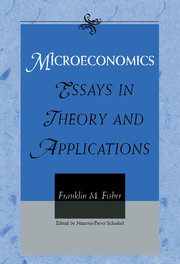Book contents
- Frontmatter
- Contents
- Introduction
- Part I Disequilibrium and Stability
- Part II Welfare Economics and Consumer Theory
- 12 Income Distribution, Value Judgments, and Welfare (1956)
- 13 Income Distribution, Value Judgments, and Welfare: A Correction (1957)
- 14 How Income Ought to Be Distributed: Paradox Lost (1961)
- 15 Advertising and Welfare: Comment (1979)
- 16 Household Equivalence Scales and Interpersonal Comparisons (1987)
- 17 Household Equivalence Scales: Reply (1990)
- 18 Normal Goods and the Expenditure Function (1990)
- Part III Applications of Microeconomic Theory
- Part IV Industrial Organization, Economics, and the Law
- Part V Public Policy Applications
- Epilogue
- Indexes
14 - How Income Ought to Be Distributed: Paradox Lost (1961)
Published online by Cambridge University Press: 20 March 2010
- Frontmatter
- Contents
- Introduction
- Part I Disequilibrium and Stability
- Part II Welfare Economics and Consumer Theory
- 12 Income Distribution, Value Judgments, and Welfare (1956)
- 13 Income Distribution, Value Judgments, and Welfare: A Correction (1957)
- 14 How Income Ought to Be Distributed: Paradox Lost (1961)
- 15 Advertising and Welfare: Comment (1979)
- 16 Household Equivalence Scales and Interpersonal Comparisons (1987)
- 17 Household Equivalence Scales: Reply (1990)
- 18 Normal Goods and the Expenditure Function (1990)
- Part III Applications of Microeconomic Theory
- Part IV Industrial Organization, Economics, and the Law
- Part V Public Policy Applications
- Epilogue
- Indexes
Summary
A few years ago Robert Strotz propounded an apparent paradox in the ethics of income distribution and called for its resolution. Briefly stated, the paradox is this: Strotz places a number of apparently ethically desirable or innocuous restrictions on the class of admissible social welfare functions in a one-commodity n-person world, yet proves that the only member of the admissible class is an apparently ethically unacceptable welfare function, namely, that which is maximized by maximizing total income without regard for the way in which the income is distributed among persons. It must therefore be the case either that at least one of the apparently ethically acceptable conditions is in fact ethically abhorrent or that the apparently ethically abhorrent result is in fact ethically acceptable. Strotz invites the reader to decide between the alternatives and, if selecting the first, to point out the guilty condition or conditions.
This paper undertakes to do just that. In the next section we briefly summarize Strotz's paper; the following sections then discuss our objections to Strotz's assumptions; finally, we discuss the implications of these criticisms for some of the other relevant literature.
Strotz's restrictions are ethical interpretations of Chernoff s decision-making axioms. We need not discuss all of them in detail but refer the reader to the original article for the full treatment, which must be simplified here.
Strotz assumes a one-commodity world (the commodity is called “money income”). All individuals are assumed to have linear Von Neumann–Morgenstern utility functions – they have neither risk aversion nor risk preference (the utility functions may, of course, differ in intercept and slope).
- Type
- Chapter
- Information
- MicroeconomicsEssays in Theory and Applications, pp. 230 - 256Publisher: Cambridge University PressPrint publication year: 1999



